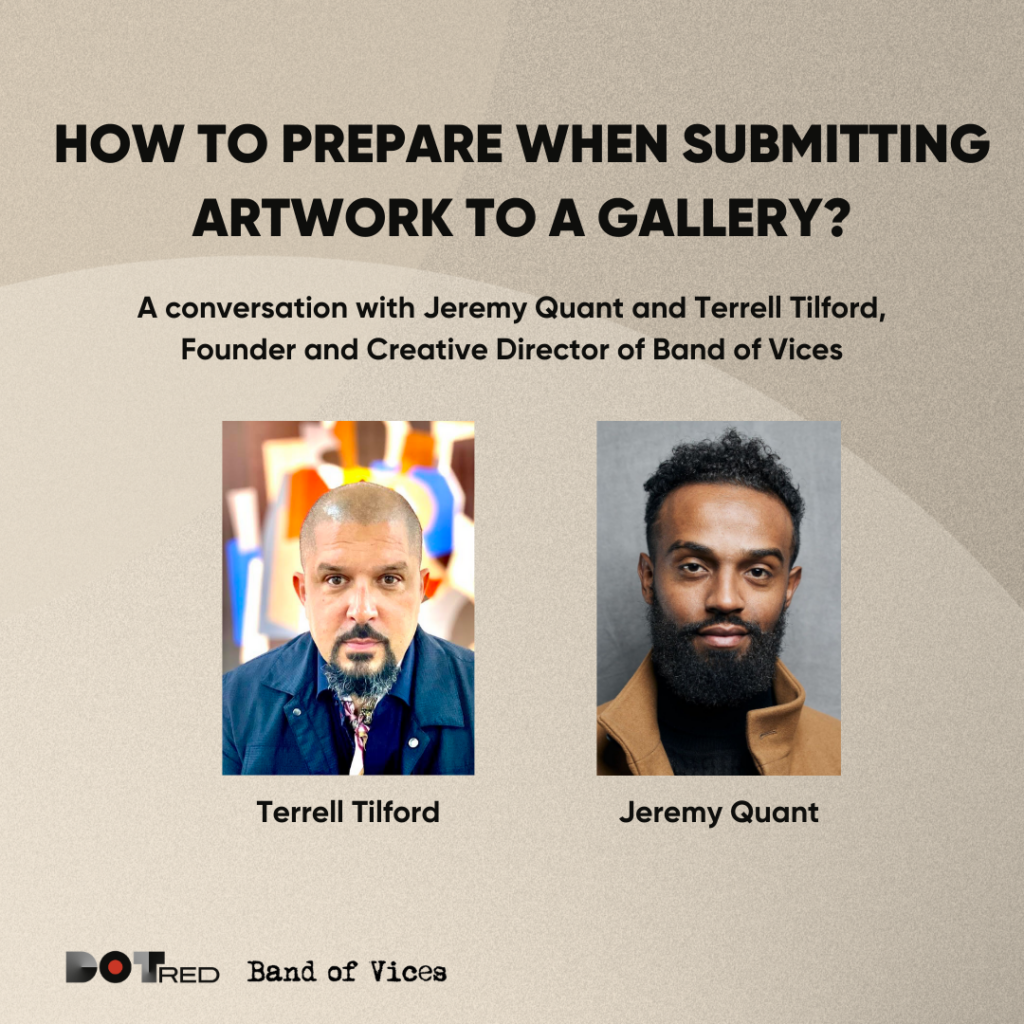
In our Instagram Live interview with Dot Red CEO Jeremy Quant and Terrell Tilford, the visionary founder, creative director, of Band of Vices, offered invaluable guidance for artists seeking to navigate the often-complex gallery landscape. Tilford’s gallery, Band of Vices, is not just a space for displaying art; it is a nurturing environment where the artist’s growth, mental health, and personal journey are given top priority. This ethos is what makes Band of Vices a unique and essential part of the contemporary art scene as an arts and culture company.
The Person, the Artist, the Art: The approach of Band of Vices
Tilford’s approach to running Band of Vices is rooted in a profound respect for the individual behind the artwork. “First goes the person, then goes the artist, then goes the art,” Tilford emphasized during the interview. This philosophy shapes every interaction at Band of Vices, where the focus is on fostering the overall well-being of the artist, allowing them to thrive both personally and creatively.
This people-first approach means that Band of Vices is deeply invested in the personal and professional development of the artists they work with. Tilford and his team are committed to helping artists find their unique voice, explore new dimensions of their work, and build a sustainable creative practice. This support extends beyond the art itself, encompassing the mental and emotional well-being of the artist.
Essential Advice for Artists: Tenacity, Curiosity, and Defiance
Throughout the interview, Tilford shared a wealth of practical advice for artists who are preparing to present their work to galleries. Central to his recommendations were three key qualities: tenacity, defiance and curiosity. He encouraged artists to remain steadfast in their vision and to continue creating even in the face of rejection, and to show interest in the galleries in which they wish to exhibit their work. “It can’t be just a ‘Here’s my work and call me when there’s a check’ sort of approach”.
Tilford posed thought-provoking questions to artists, challenging them to consider their motivations: “If I say no as a gallery, would you continue doing this?”. Questions like this are designed to help artists assess their dedication and resilience, which are crucial for long-term success in the art world.
The Importance of Documentation and Consistency
Tilford also underscored the importance of having one’s work well documented and archived. Knowing your work inside and out, and being able to present it effectively, is vital when approaching galleries. However, he emphasized that creating art should not be solely for the purpose of presentation. Instead, artists should focus on building a body of work that reflects their ongoing creative and personal journey and exploring where that inspiration comes from.
“Be consistent,” Tilford advised. “Keep on working even if a gallery says no. It’s not personal and you can continue identifying how the work can transform to better go with the gallery’s visions, or to find a gallery that aligns more with what you do”. This perseverance, according to Tilford, is what ultimately leads to artistic growth and success.
Building Partnerships with Galleries
Tilford believes that the relationship between artists and galleries should be one of partnership. He encouraged artists to approach galleries with a sense of mutual respect and understanding, seeing galleries as a support to help artists grow. This involves doing thorough research on the gallery’s background, understanding whether their work aligns with the gallery’s vision, and maintaining open communication.“Ask questions and show interest in the places you want to work or partner with.” By fostering these relationships, artists can gain valuable mentorship and build lasting connections within the art community.
In a more technical sense, Terrell recommends artists to “Read contracts and consignments carefully,” Tilford advised. He highlighted the importance of being very careful when reading contracts and being straightforward with the gallery if you don’t agree or understand any part of the contract. This creates trust and contributes to the understanding of the purpose of the agreement.
Conclusion
Terrell Tilford’s conversation with Jeremy Quant was a masterclass in the intricacies of the artist-gallery relationship and the importance of staying curious and resilient during the process of finding where to sell your art. By prioritizing the individual, fostering creative partnerships, and encouraging resilience, Dot Red continues to revolutionize the art world by making artists and their work more accessible through educational conversations and digital technologies that accelerate buyer purchasing decisions. Check out our services to see more of what we offer for artists, and watch the full interview here!

